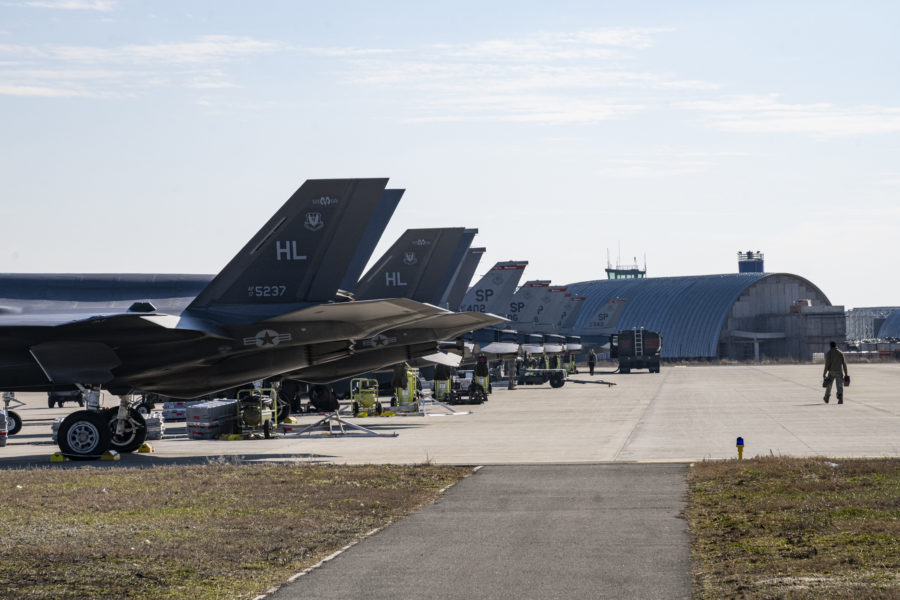BUCHAREST, Romania—Russia’s war repositioning to Ukraine’s south and east has heightened worries for NATO Black Sea ally Romania, which saw Russia close within 30 miles of its coastline when it captured Snake Island from Ukraine Feb. 24.
American F-16s are currently conducting a NATO enhanced air policing mission in Romania, and in February the U.S. sent two F-35s to help deter Russia.
Romania has been a stalwart American ally in recent years, hosting roughly 800 American troops on its military bases, including the air policing mission at Fetesti Air Base near the strategically important Danube river delta.
Romanian government officials who spoke to Air Force Magazine in Bucharest worried that Russian President Vladimir Putin appears to be moving towards a strategy of uniting the Russian-speaking areas of Ukraine under Moscow’s control.
From a strategic perspective, Russia needs a land bridge to Crimea, evident by its bombardment of Mariupol, to form a link with the Donbas. The vital port city of Odesa is Russian-speaking and could provide a connection to the Russian occupied Transnistria region of Moldova. That would put Russia directly on NATO’s border with Romania, and transfer southern Ukraine’s mineral and hydrocarbon riches to Russian control.
The American presence of troops and air power has helped to deter Russia so far. But, Romania wants more troops and a permanent U.S. presence. Romania also continues to benefit from American air power while it slowly builds its own modern Air Force.
Romania’s combat aircraft consist of 17 F-16s and a small number of upgraded MiG-21 Lancers. While Romania has ordered 48 total secondhand F-16s with a stated eventual transition to the F-35, most of its F-16s have not been delivered. Romanian pilots also require additional training before they can take on combat missions.
In the meantime, the U.S. Air Force is helping to fill the air defense gap in the southeastern corner of NATO.
“They won’t stop,” a Romanian government official told Air Force Magazine, speaking of Russia.
“Either you stop Russia in Ukraine, or you’re going to fight it on the NATO soil, on the EU soil,” the official added on condition of anonymity in order to discuss sensitive security discussions.
The official observed that Russia has not closed Ukrainian skies or used its array of electronic warfare capabilities.
“You have a big question mark, where’s the rest?” the official posed.
The official suggested the possibility that Russia is keeping some of its most sophisticated capabilities “in reserve for a different purpose, for a different project, for a different operation that is supposed to come afterwards.”
In recent days Romania has detected fast-moving drones passing through its airspace, one of which crashed in Croatia after passing through Romania and Hungary. Long intimidated by Russia, hybrid warfare increased once Russia seized Crimea in 2014 and established a de facto border just 200 miles from NATO shores.
Romania is also surrounded by pro-Russia governments, Hungary and Serbia, and a weak unaligned Moldova. While Bulgaria, its neighbor to the south, is also a NATO member, the country has heavy investment and energy ties to Russia.
The Romanian official and others who spoke to Air Force Magazine said the Romanian government views Russia in a historical context, aspiring to re-establish its historic empire with a population willing to sacrifice losses to maintain Russian greatness.
The officials also pointed to powerful Russian propaganda which has kept much of its people in the dark about the true losses suffered in Ukraine. A move to consolidate the Russian-speaking portions of Ukraine, one official said, could begin a years-long Russification of the population.
As to the repositioning of Russian troops within Ukraine, Romanian officials do not believe Putin will be satisfied seizing Eastern Ukraine or even making Ukraine a land-locked country.
“They want the whole pie, so they won’t stop,” he said. “It’s a long war.”
A Romanian defense official told Air Force Magazine that the country needed the U.S. to participate in NATO air policing for the first time.
“Romania is looking forward to have U.S. Air Force doing air policing in country,” the official said on condition of anonymity when asked if Romania sought a greater American Air Force presence.
On the morning of Putin’s Feb. 24 invasion of Ukraine, two F-35s arrived in Romania from Spangdahlem Air Base, Germany to join eight F-16s at Fetesti. The fifth-generation F-35s, from the 388th Fighter Wing at Hill Air Force Base, Utah, are no longer in Romania, but experts say they are a powerful asset both for deterrence and intelligence collection, helping Ukraine battle back Russian advances.
“You have an extraordinary collection asset airborne every time that that fighter gets aloft,” Heritage defense analyst John “JV” Venable told Air Force Magazine in a phone interview.
“It triangulates and it fixes and we’re able to provide that detailed analysis, that detailed intel, we’re able to provide that directly to the Ukrainian fighting forces,” he said. “If we continue to keep those assets there, then they get that much more of it.”
The Romanian government official said the country, which was already investing 2 percent of its GDP on defense, has committed to spend 2.5 percent and is seriously weighing an increase to 3 percent of GDP spending on defense in the wake of Russia’s long-term threat to its and NATO’s national security.
Part of that investment has been in base infrastructure used by American troops and aircraft at Fetesti, Campia Turzii, and Mihail Kogălniceanu. European Deterrence Initiative (EDI) funds have also invested in the air base infrastructure and pre-positioning used by Americans.
“If the Russians are taking Odesa, they are going to become our neighbors also on land,” the Romanian government official said. “They are taking a slice, what they can today, but they will come back because they want the whole pie.”
